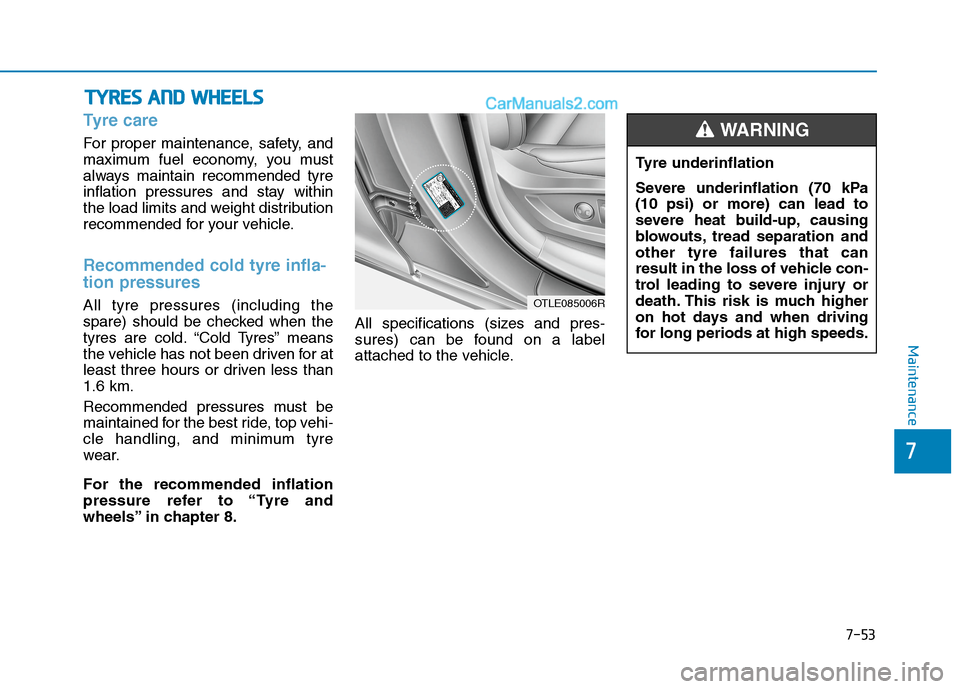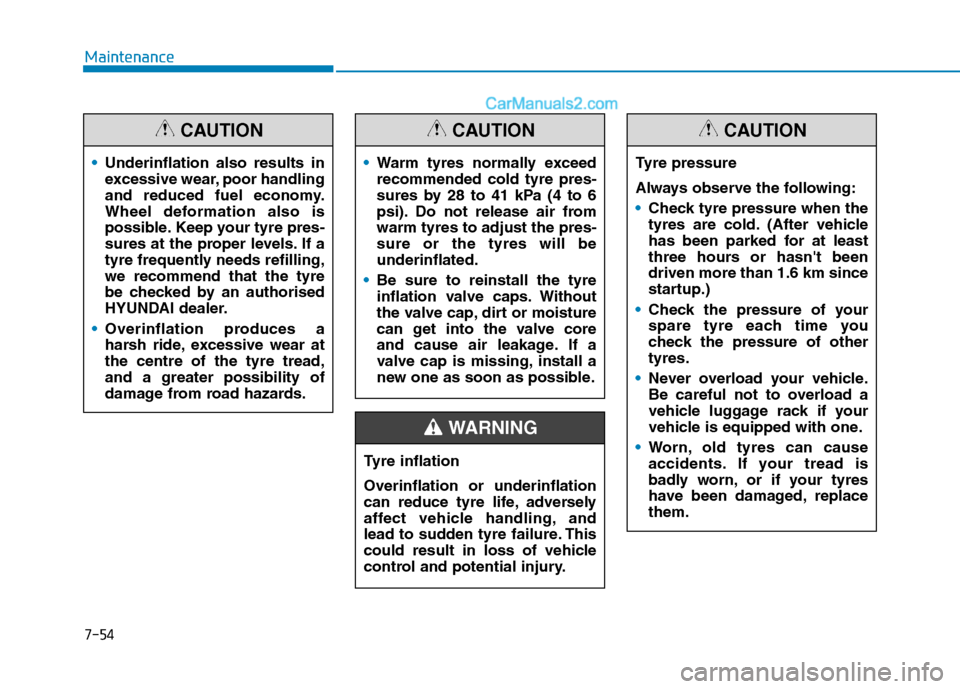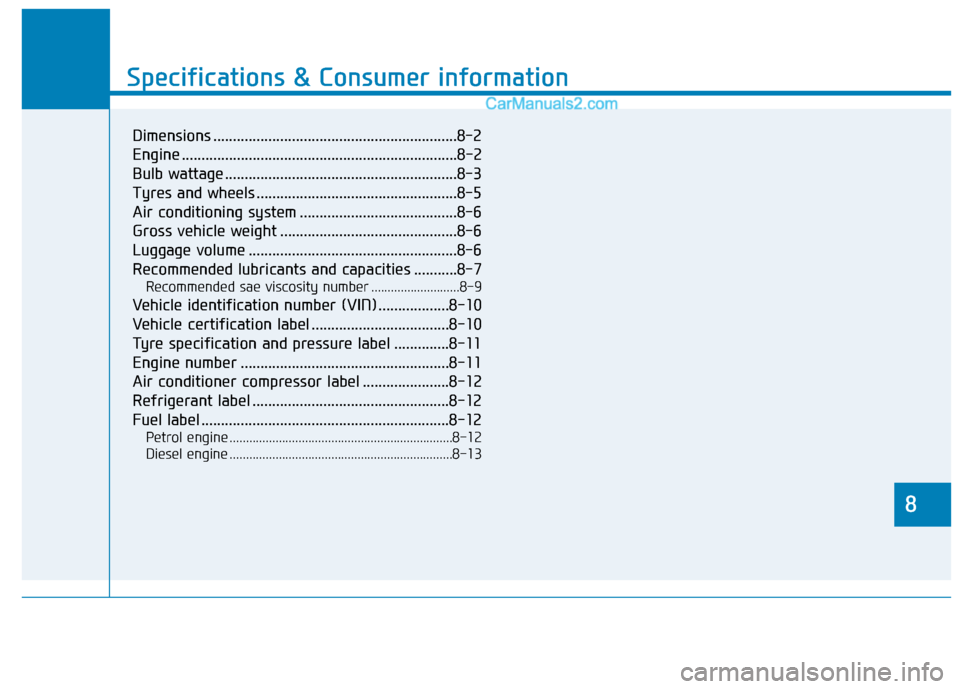Page 543 of 637

7-27
7
Maintenance
E EX
XP
PL
LA
AN
NA
AT
TI
IO
ON
N
O
OF
F
S
SC
CH
HE
ED
DU
UL
LE
ED
D
M
MA
AI
IN
NT
TE
EN
NA
AN
NC
CE
E
I
IT
TE
EM
MS
S
Engine oil and filter
The engine oil and filter should be
changed at the intervals specified in
the maintenance schedule. If the
vehicle is being driven in severe con-
ditions, more frequent oil and filter
changes are required.
Drive belts
Inspect all drive belts for evidence of
cuts, cracks, excessive wear or oil
saturation and replace if necessary.
Drive belts should be checked peri-
odically for proper tension and
adjusted as necessary.
Fuel filter (cartridge)
A clogged-up fuel filter may limit the
vehicle driving speed, damage the
emission system, and cause hard
starting. When a considerable
amount of foreign substances are
accumulate in the fuel tank, the fuel
filter should be replaced.
Upon installing a new fuel filter, oper-
ate the diesel engine for several min-
utes, and check the connections for
any leakages. We recommend that
you have the fuel filter replaced by an
authorised HYUNDAI dealer.
Fuel lines, fuel hoses and con-
nections
Check the fuel lines, fuel hoses and
connections for leakage and dam-
age. We recommend that the fuel
lines, fuel hoses and connections be
replaced by an authorised HYUNDAI
dealer. When you are inspecting the
drive belt, place the ignition
switch to the LOCK/OFF or ACC
position.
CAUTION
Diesel Only
Never manipulate or modify the
injection system whilst running
the diesel engine or within 30
seconds after turning the diesel
engine OFF. The high-pressure
pump, high-pressure pipes, rail,
and injectors are still subject to
the high pressure right after
stopping the diesel engine.
When the fuel leakage vents
out, it may cause serious body
injury. Any people, who are
implemented with the artificial
cardiac pacemaker, should
remain away from the ECU or
the wiring harness by at least 30
cm whilst running the diesel
engine. The high currents of the
common rail system produce a
considerable amount of mag-
netic fields.
WARNING
Page 569 of 637

7-53
7
Maintenance
T TY
YR
RE
ES
S
A
AN
ND
D
W
WH
HE
EE
EL
LS
S
Tyre care
For proper maintenance, safety, and
maximum fuel economy, you must
always maintain recommended tyre
inflation pressures and stay within
the load limits and weight distribution
recommended for your vehicle.
Recommended cold tyre infla-
tion pressures
All tyre pressures (including the
spare) should be checked when the
tyres are cold. “Cold Tyres” means
the vehicle has not been driven for at
least three hours or driven less than
1.6 km.
Recommended pressures must be
maintained for the best ride, top vehi-
cle handling, and minimum tyre
wear.
For the recommended inflation
pressure refer to “Tyre and
wheels” in chapter 8.All specifications (sizes and pres-
sures) can be found on a label
attached to the vehicle.Tyre underinflation
Severe underinflation (70 kPa
(10 psi) or more) can lead to
severe heat build-up, causing
blowouts, tread separation and
other tyre failures that can
result in the loss of vehicle con-
trol leading to severe injury or
death. This risk is much higher
on hot days and when driving
for long periods at high speeds.
WARNING
OTLE085006R
Page 570 of 637

7-54
Maintenance
Underinflation also results in
excessive wear, poor handling
and reduced fuel economy.
Wheel deformation also is
possible. Keep your tyre pres-
sures at the proper levels. If a
tyre frequently needs refilling,
we recommend that the tyre
be checked by an authorised
HYUNDAI dealer.
Overinflation produces a
harsh ride, excessive wear at
the centre of the tyre tread,
and a greater possibility of
damage from road hazards.
CAUTION
Warm tyres normally exceed
recommended cold tyre pres-
sures by 28 to 41 kPa (4 to 6
psi). Do not release air from
warm tyres to adjust the pres-
sure or the tyres will be
underinflated.
Be sure to reinstall the tyre
inflation valve caps. Without
the valve cap, dirt or moisture
can get into the valve core
and cause air leakage. If a
valve cap is missing, install a
new one as soon as possible.
CAUTION
Tyre pressure
Always observe the following:
Check tyre pressure when the
tyres are cold. (After vehicle
has been parked for at least
three hours or hasn't been
driven more than 1.6 km since
startup.)
Check the pressure of your
spare tyre each time you
check the pressure of other
tyres.
Never overload your vehicle.
Be careful not to overload a
vehicle luggage rack if your
vehicle is equipped with one.
Worn, old tyres can cause
accidents. If your tread is
badly worn, or if your tyres
have been damaged, replace
them.
CAUTION
Tyre inflation
Overinflation or underinflation
can reduce tyre life, adversely
affect vehicle handling, and
lead to sudden tyre failure. This
could result in loss of vehicle
control and potential injury.
WARNING
Page 596 of 637
7-80
Maintenance
Fuse Name SymbolFuse ratingCircuit Protected
FUSE
DCU 3DCU315A Not Used
DCU 2DCU220A Not Used
DCU 1DCU120A Not Used
WIPER 125A [W/O Smart Key] Ignition Switch, [With Smart Key] PDM (IG2) Relay
TCU 115A PCM/ECM/TCM
ECU 320A [G4NA/G4FJ] PCM/ECM
HORN15A Horn Relay
BATTERY
MANAGEMENT10A Not Used
SENSOR 210A
[G4NA] Oil Control Valve #1/#2, Variable Intake Solenoid Valve,
Camshaft Position Sensor #1/#2, Purge Control Solenoid Valve,
E/R Junction Block (RLY. 1, RLY. 3)
[G4FJ] Oil Control Valve #1/#2, Purge Control Solenoid Valve,
RCV Control Solenoid Valve, E/R Junction Block (RLY. 1, RLY. 3)
[D4HA] Crankshaft Position Sensor, EGR Cooling Bypass Solenoid Valve,
Stop Lamp Switch, E/R Junction Block (RLY. 3, RLY. 6)
SENSOR 115A [G4NA/G4FJ] Oxygen Sensor (Up/Down)
[D4HA] Lambda Sensor #1/#2, Electronic VGT Actuator, Fuel Pressure Regulating
Valve, PM (Particulate Matter) Sensor, E/R Junction Block (RLY. 1)
Page 625 of 637

8
Specifications & Consumer information
8
Specifications & Consumer information
8
Dimensions ..............................................................8-2
Engine ......................................................................8-2
Bulb wattage ...........................................................8-3
Tyres and wheels ...................................................8-5
Air conditioning system ........................................8-6
Gross vehicle weight .............................................8-6
Luggage volume .....................................................8-6
Recommended lubricants and capacities ...........8-7
Recommended sae viscosity number ...........................8-9
Vehicle identification number (VIN) ..................8-10
Vehicle certification label ...................................8-10
Tyre specification and pressure label ..............8-11
Engine number .....................................................8-11
Air conditioner compressor label ......................8-12
Refrigerant label ..................................................8-12
Fuel label ...............................................................8-12
Petrol engine ....................................................................8-12
Diesel engine ....................................................................8-13